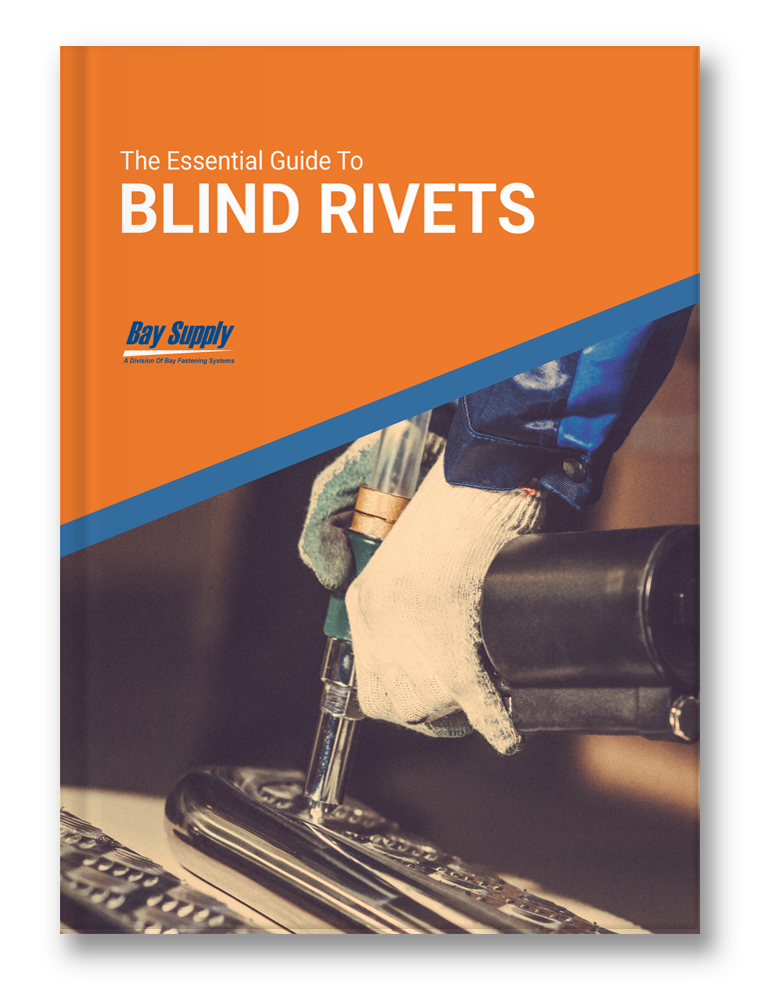Chapter 4
Types of Blind Rivet Tools
Just as there are different blind rivets for different applications, there are different types of blind rivet tools. For example, some rivets require more power to install, and various tools manage the excess mandible differently.
Solid rivets have been used for millennia and can be installed using a hammer. Solid blind rivets require more power to install, so they are usually installed using hydraulic or pneumatic rivet tools.
You can use manual rivet tools for smaller jobs, occasional repairs, or where power is unavailable. Manual rivet tools are long-handled devices that use the leverage power of the handles to set the rivet. Handheld rivet tools can be useful for field repairs, such as repairing a truck bed or a highway sign. Of course, handheld tools are slower and can be tiring to use, so they are best for occasional use or when you only have a few rivets to install.
For assembly lines or applications where there are multiple rivets to install, you need power tools. Most factories use pneumatic or hydraulic tools because they are fast, efficient, and powerful. These heavy-duty tools require a hose and a compressor to generate power, so they are ideal for stationary applications but aren’t very portable.
Pneumatic rivet tools use compressed air to propel the rivets into place quickly and easily. Pneumatic tools require compressed air to operate, so they are connected to a compressor via hoses. Pneumatic tools can be heavy, or they can be extremely lightweight. Pneumatic rivet tools also have the advantage of providing consistent, quality riveting. However, the hoses limit mobility and range, and the compressor needs to be adjusted to the right pressure for quality work.
More installers are using battery-operated rivet tools for portable applications or where they need to access tight spaces. Although they are not as powerful as hydraulic or pneumatic tools and tend to use smaller nose pieces, battery-powered rivet tools are versatile. Battery technology continues to improve, so portable rivet tools are powered by 12-, 14-, 16-, 18-, 18.8-, or 20-volt batteries. They are also lighter and can be used for extended periods without recharging. Batteries have become standardized, and fast battery chargers are increasing productivity using portable tools.
One of the biggest mistakes most people make is using the wrong nose assembly for the job. Different types of rivets require matching nose assemblies for proper installation. It’s easy to choose a nose piece with the wrong grip range.
Rivet tool makers such as Huck have developed a portable power rig for hydraulic and pneumatic tools to address this problem. This battery-powered rig uses the same hoses for hydraulic and pneumatic tools but in a battery-powered unit that can be taken anywhere. The real advantage of the portable power rig is it can use the entire range of nose pieces for any job.
When shopping for the right riveting tools, you want to consider which nose pieces you will need and choose the right tool to accommodate them. You also want to consider the pull stroke of the tool, which is the distance the tool must pull the mandrel to set the rivet. Different applications require a different degree of force, so consider the traction power needed to set the rivets. Traction power is usually measured in pounds or newtons (N). One pound is 4.45N.
If you are looking for a pneumatic or hydraulic tool, then power may not be a consideration, but you want a lightweight and easy-to-use tool. A heavy tool will tire the installer quickly. For portable blind rivet tools, you want to consider the tool's weight and the battery voltage, which determines pull strength, time to recharge, ease of use, and other factors.
![]() Electronics: Assembly of housings and mounting of circuit boards
Electronics: Assembly of housings and mounting of circuit boards![]() Agriculture: Manufacturing of agricultural equipment and field repair and maintenance
Agriculture: Manufacturing of agricultural equipment and field repair and maintenance![]() Solar power and green energy: Manufacturing, installation, service, and repair of solar arrays, wind power units, and other green energy systems
Solar power and green energy: Manufacturing, installation, service, and repair of solar arrays, wind power units, and other green energy systems![]() Transportation: Fleet service, maintenance, service, and modifications for trucks, buses, and transportation equipment
Transportation: Fleet service, maintenance, service, and modifications for trucks, buses, and transportation equipment![]() Railcars and mining: Heavy-duty railway and mining equipment manufacturing, service, repair, and maintenance, including rolling stock and rails
Railcars and mining: Heavy-duty railway and mining equipment manufacturing, service, repair, and maintenance, including rolling stock and rails![]() Lighting: Commercial and residential light fixtures, assemblies, and controls
Lighting: Commercial and residential light fixtures, assemblies, and controls











